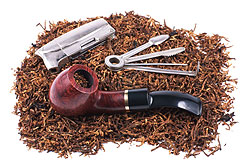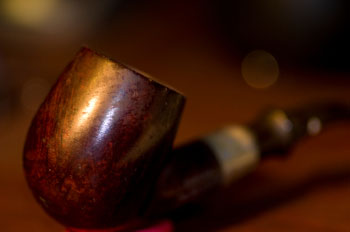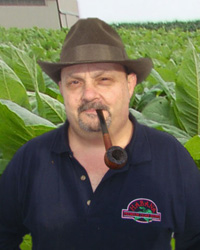Russ Ouellette
 I have contended over the years that the main reason so many people have tried a pipe and have subsequently given it up is because they frequently burn their tongue. This most often happens because they don’t have sufficient guidance and buy less-than-stellar products, but also because no one is there to help them learn how to pack and smoke a pipe. So I’ll lay out some strategies and tips to mitigate the dreaded leathertongue.
I have contended over the years that the main reason so many people have tried a pipe and have subsequently given it up is because they frequently burn their tongue. This most often happens because they don’t have sufficient guidance and buy less-than-stellar products, but also because no one is there to help them learn how to pack and smoke a pipe. So I’ll lay out some strategies and tips to mitigate the dreaded leathertongue.
I’m quite positive that the number one reason for getting a pipe too hot is improper packing. If a pipe is packed too tightly, it will cause the smoker to puff harder and more often in an attempt to get a decent amount of smoke. Of course, that will turn a pipe into a furnace. Packing too loosely will cause the same problem, as the smoke stream will be too thin. To exacerbate the problem, the common "cure" is to overuse the tamper, leading to making the draw too tight and that’s fundamentally the same as overpacking. There are a number of packing methods that will solve this. The most common is the "three-layer" approach, which I’ve described in an article "How to Pack a Pipe". A widely used alternative approach that many swear by is the Frank method, which takes a little practice, but I’ve found it to be quite effective. [Editor’s note: Here is part 1 of a two-part series on pipe packing by Bob Tate: Tobacco Pipe Packing Methods – Part 1]
Moisture content of the tobacco will also have an impact on heat issues. It’s the primary reason my own blends tend somewhat to the dry side. Also, moist tobacco compresses (and stays compressed) more easily, which can lead to overpacking. When you combine the more frequent puffing with additional water content, the result will be steam, and that is much more likely to burn your tongue than smoke. A lot of this type of difficulty can be avoided by allowing your tobacco to dry out a bit by taking a bowlful out of its package and allowing it to sit out on a piece of paper for 45 minutes to an hour before packing.
What a smoker uses to light the pipe will also have an impact. Matches burn at 600 to 800 degrees Fahrenheit, whereas butane soft-flame lighters run over 1900 degrees. So, this alone can make a difference. Of course, matches can be inconvenient and ineffective under certain circumstances, so use of a lighter can be unavoidable.
The type of tobacco can certainly be an influence. Very moist, flavored tobaccos, especially when there’s a lot of humectant added (which maintain higher moisture levels), can smoke hot, as it’s nearly impossible to dry them down to a useable level. Thankfully, there aren’t all that many blends like that, but when used, these tobaccos can be a real problem. Virginia tobaccos will tend to burn hotter because of the high sugar level. In the case of Virginias, letting them get too dry can be a huge problem, as they will fire up readily. If your tastes run toward Virginias, but the heat is too much, smoking them in flake form, and not rubbing them out too much can certainly help. Also, if you don’t have an aversion to Perique, the addition of this flavorful leaf can bring down the combustion temperature enough to make Virginias more manageable. Overall, I find Latakia-based blends to be the coolest smoking. Of course, if you don’t like the smoky flavor of this black leaf, that won’t be of any real help at all.
 The selection of the pipe will certainly make a big difference on smoking temperature. The first and most obvious thing is the length of the pipe, not necessarily the length from button to bowl, but the total length of the drafthole. A calabash may only measure as little as six inches in total, but with the deep bend, and the chamber underneath the bowl, the smoke has to travel a much greater distance than that. A churchwarden is a long pipe which is often selected specifically for the fact that it tends to be cooler than most, and is certainly a good choice for the hot smoker. Also, pipes without a substantial amount of wood can be a bit hot. Pipes that are heavily lacquered can be a problem in this regard as well. Meerschaums may be hot to handle, but they generally deliver a cool smoke as the material conducts heat away from the tobacco and absorb additional moisture well. One big contributing factor to heat issues is not letting your pipes rest. When a briar, meerschaum or corncob has absorbed too much moisture, it blocks the heat and forces it inward, so my rule of thumb is what I live by: However many bowls you have smoked in a given day, let the pipe rest that many days.
The selection of the pipe will certainly make a big difference on smoking temperature. The first and most obvious thing is the length of the pipe, not necessarily the length from button to bowl, but the total length of the drafthole. A calabash may only measure as little as six inches in total, but with the deep bend, and the chamber underneath the bowl, the smoke has to travel a much greater distance than that. A churchwarden is a long pipe which is often selected specifically for the fact that it tends to be cooler than most, and is certainly a good choice for the hot smoker. Also, pipes without a substantial amount of wood can be a bit hot. Pipes that are heavily lacquered can be a problem in this regard as well. Meerschaums may be hot to handle, but they generally deliver a cool smoke as the material conducts heat away from the tobacco and absorb additional moisture well. One big contributing factor to heat issues is not letting your pipes rest. When a briar, meerschaum or corncob has absorbed too much moisture, it blocks the heat and forces it inward, so my rule of thumb is what I live by: However many bowls you have smoked in a given day, let the pipe rest that many days.
Another thought is to restrict the amount of air getting into the mix. I picked this tip up from my father, who was a man who always seemed to have his pipe in his hand or mouth. When his pipe either got hot or threatened to go out, he would hold a matchbook cover or his fingers over the top of the bowl. I asked him why he did it, and he explained that, by cutting down on the oxygen, the combustion would be lower, and if he had to puff a little more to get it going again, it would keep the pipe from getting too hot. I’ve used this extensively over the years, and have found that it works very well.
The last thought is to look at your habits. Do you clench? If so, you may be puffing more often without even realizing it. Give your jaw and tongue a rest, and any problems you have may disappear. Beside that, holding a pipe in your mouth constantly may cause saliva to run into the chamber, which will make it more difficult to keep lit, which causes you to puff more which leads to…well, you get it.
In the meantime, keep your cool.
|
Russ Ouellette is the blender/creator of the Hearth & Home series of tobaccos for Habana Premium Cigar Shoppe and www.pipesandcigars.com in Albany, NY. He has been a pipe smoker and blender for over 30 years, and enjoys feedback from the pipe smoking public. You can reach Russ at russo@pipesandcigars.com or by calling 1-800-494-9144 on Monday, Wednesday and Thursday from 9 am to 5 pm and Friday from 1 pm to 5 pm. |



















Great info and a joy to read.
Great article Russ! Since returning to pipe smoking I have had the very same issue you addressed here, and will be trying them out tonight for my evening pipe. I beleive there are many a new pipers that will benefit from these suggestions, and will find their experience much more enjoyable.
A good read indeed Russ. Thank you for the refresher course. I’m looking forward to seeing how much cooler a churchwarden smokes than my other pipes; and if it will have any affect on my smoking cadence. If it smokes cooler I might want to puff more… Oh no! 🙂
Wow! When I first started smoking pipes, about twenty five years ago. I used to go for the tobacco that had bite to it! Nowa days I like a smoke with less of a bite. Thanks will try these suggestions!
Man I am sooo glad there is information like this available to the youngbucks out there fairly new to pipe smoking. (1-15 yrs). Russ when I was coming up all we had was our dads, grandfathers etc. to mentor us and the occassional folks in pipe shops. But, lemme tell when I was a guy 16-18 or so years old it was intimidating a bit to walk in to a place that sold pipes and tobaccos whose selection was bewildering not to mention the guy behind the counter talking with other ‘mature’ folks about pipes and such.
Anyway ‘I’ felt that way. I guess the employee ther thought it was a bit funny for such a young person to be intersted in pipes and tobaccos. However their gigantic tin selection was easy to browse. So I was able to chose blends and just carry it to the counter. I came across Balkan Sobranie blends back in the late 60’s this way and chose it because the tin art was ‘cool’ and old timey and rustic looking.
Russ I’m in my mid 50’s and still learning and re-learning thru service like you offer here through the articls you write along with the other prodigious, scholarly writers here at PC. I just want to say a big THANK YOU
-Tony
This article here covers most of the problems I was having yesterday. Thanks for shedding light on these areas.
Great one, Russ. I’ve been using the 2 fingers over the bowl trick since I started and it does exactly as you said.
Thanks for the read, I will lay my wet pipes down to rest and rotate more.
Good piece, as usual, Russ. Thanks!
It’s always a pleasure to read such informative and well written articles. Your enthusiasm for, and dedication to, the “art of the pipe” are both palpable and contagious. Thanks! 🙂
You nailed it Russ. It took me a good six months to figure out and eliminate all of the tongue-bite inducing problems.
I use the “hand over the bowl to cut down on oxygen” technique myself after watching an elderly pipe smoker do the same. Particularly outside as it helps shield the bowl from burning too fast and hot.
For myself, I think the use of matches is a major reason tongue bite was banished.
Your article is a well-written and comprehensive list of tips that I’ll save and pass on to new smokers.
Something was nagging me since reading your article yesterday, and I now know what it is, another source of tongue burn (scorching, actually). I had recently replaced the stem on a hitherto well behaved meerschaum, and after two days of ambitious smoking my tongue was cooked! Using a set of reamers of progressive diameter, I cautiously increased the diameter of the draft hole until the draw was comfortable; and voila! no more troubles. Without realizing it, I had been puffing faster and drawing harder because the replacement stem’s diameter was too small.
Nice article, Russ, and nice catch, Cortez. Lately I’ve not been burning my tongue, and I guess these steps are becoming second nature now, particularly the packing, tamping and draw.
Simon
I have smoked a pipe off and on for 35+ years and for the longest time, I was a strictly aromatic smoker. after tears of tongue bite, I started thinking about it and came to the conclusion that I should try the Balkan and English blends to see if there was a reduction in the bite. I was totally amazed by the coolness of the good Balkan blends! When I read your article, I found it very interesting that my path followed your tips almost exactly. I still enjoy an occasional Aromatic like Peter Stokkebye Black Majesty but my main Tobacco Blends are strictly Balkan or English Blends. Keep up the good work on these very helpful tips for beginners as well as experienced pipe smokers.
Every new smoker should be shown this! It’s everything I wish I had learned on the first bowl. I cooked my mouth at first and nearly gave up, but just knew people wouldn’t smoke if it was like this and began my search for a better way.
Thanks so much for this! As a new pipe convert, the information here has been invaluable!!!
Helpful information, thank you for you’re insight
Thanks Russ, as I am new to pipe smoking. This was incredibly helpful.
Nice post, Russ. I’ve been trying to learn to smoke a pipe for years now, and you just described my main problem. I can’t find a balance between my pipe burning too hot and the tobacco going out every few minutes.
I know poor filling technique is my problem, but try as I might I just can’t get the hang of it. I’ve tried every different method I’ve read about, but on your advice I’m going back to the tried and true three-step method and try to work on that.